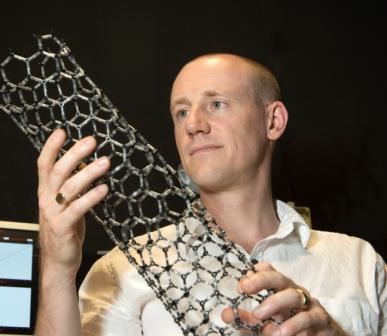Ensuring maximum solar extraction

Researchers expect silicon solar cells set to become a thing of the past and in a move in that direction a Flinders University researcher has developed a novel computer system that aims to find the best emerging carbon nanotubes to fuel the future.
As part of his PhD, postdoctoral research fellow Dr Daniel Tune (pictured) has designed a computer modelling system that shows which combination of carbon nanotubes absorb the most sunlight, therefore providing the most energy.
While silicon is predominantly used in the manufacture of solar cells, particularly most commercial rooftop solar installations, Dr Tune said scientists are now exploring the use of carbon nanotubes as a cheaper, more environmentally-friendly option.
About 50,000 times smaller than a human hair, these "˜nano' layers of can carbon produce energy by absorbing sunlight and could be used in a variety of applications, including window solar cells which absorb infrared and harmful ultra-violet radiation and turn it into electricity.
"Silicon is really expensive to produce, both in terms of money and energy consumption, but carbon is non-toxic and certainly not in short supply and carbon nanotubes could be made very cheaply," Dr Tune, based in the Centre for Nanoscale Science and Technology, of the School of Chemical and Physical Sciences, said.
"In 2011, another group of researchers from the US successfully fabricated a solar cell using carbon nanotubes, but there are more than 70 different types of carbon nanotube that could be used in such solar cells," he said.
"That raised the question of which nanotubes, and which combinations of nanotubes, are best for different applications, which is why I developed the modelling system."
Dr Tune said carbon nanotubes absorb a variety of different colours from the sunlight spectrum, therefore the system can be used to identify which colours the nanotubes absorb, how much energy they generate and what combinations absorb the most sunlight.
"There are only so many types of carbon nanotubes that can be made. Individually, they don't catch much sunlight on their own which is why it's important to know what combinations to use to maximise the benefit, depending on the application.
"For example, scientists could apply the computer model to create a combination of nanotubes that absorbs the most infrared but not visible light, creating the transparent solar cells that could be used as window coatings.
"This would have the added benefits of minimising damage to furnishings and fittings, reducing the need for air-conditioning in hot climates like Australia's, as well as improving the efficiency of local electricity grids by producing power at the point of consumption."
A paper co-authored by Dr Tune, titled: The potential sunlight harvesting efficiency of carbon nanotube solar cells, was published in the July 2013 edition of Energy and Environmental Science.


































